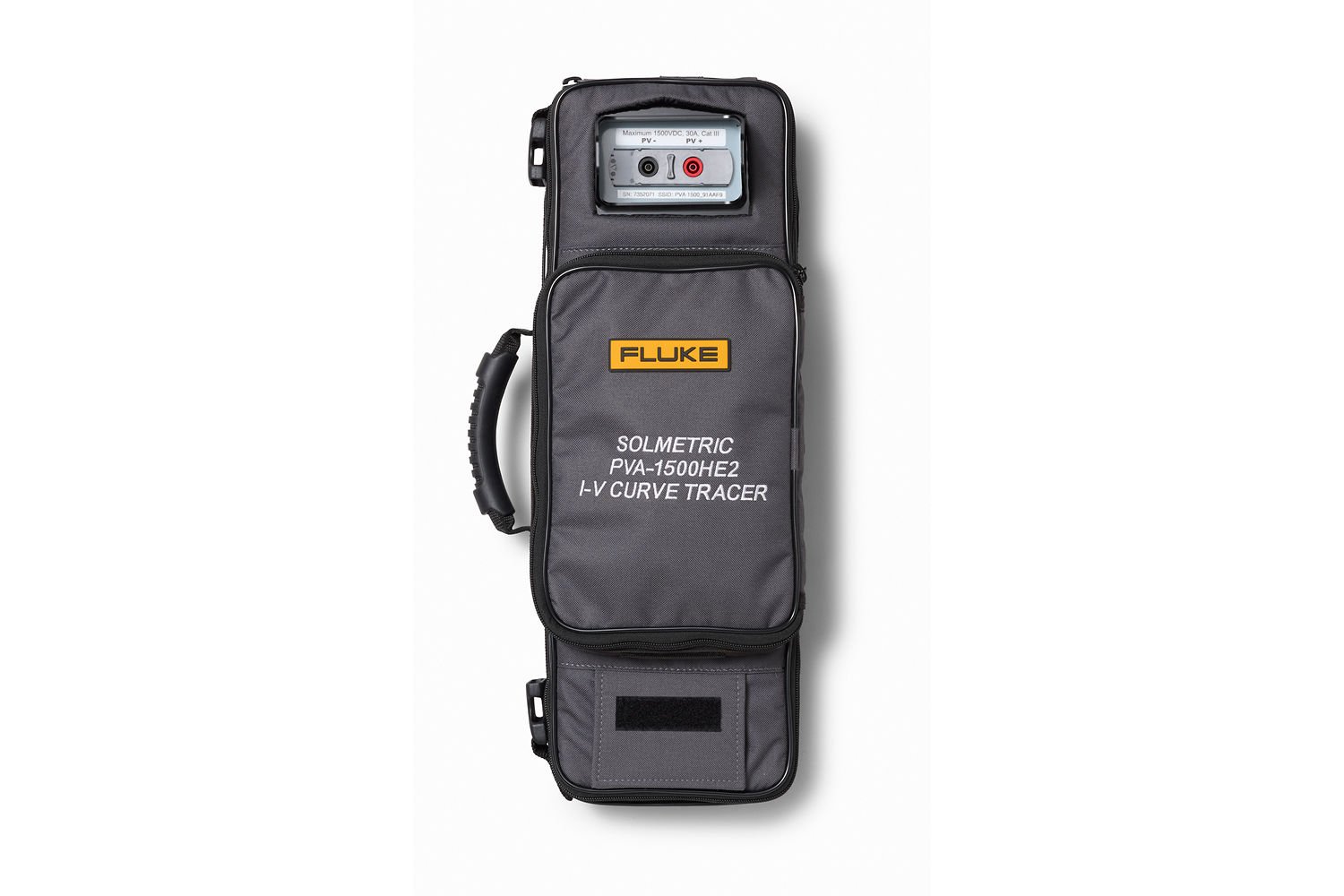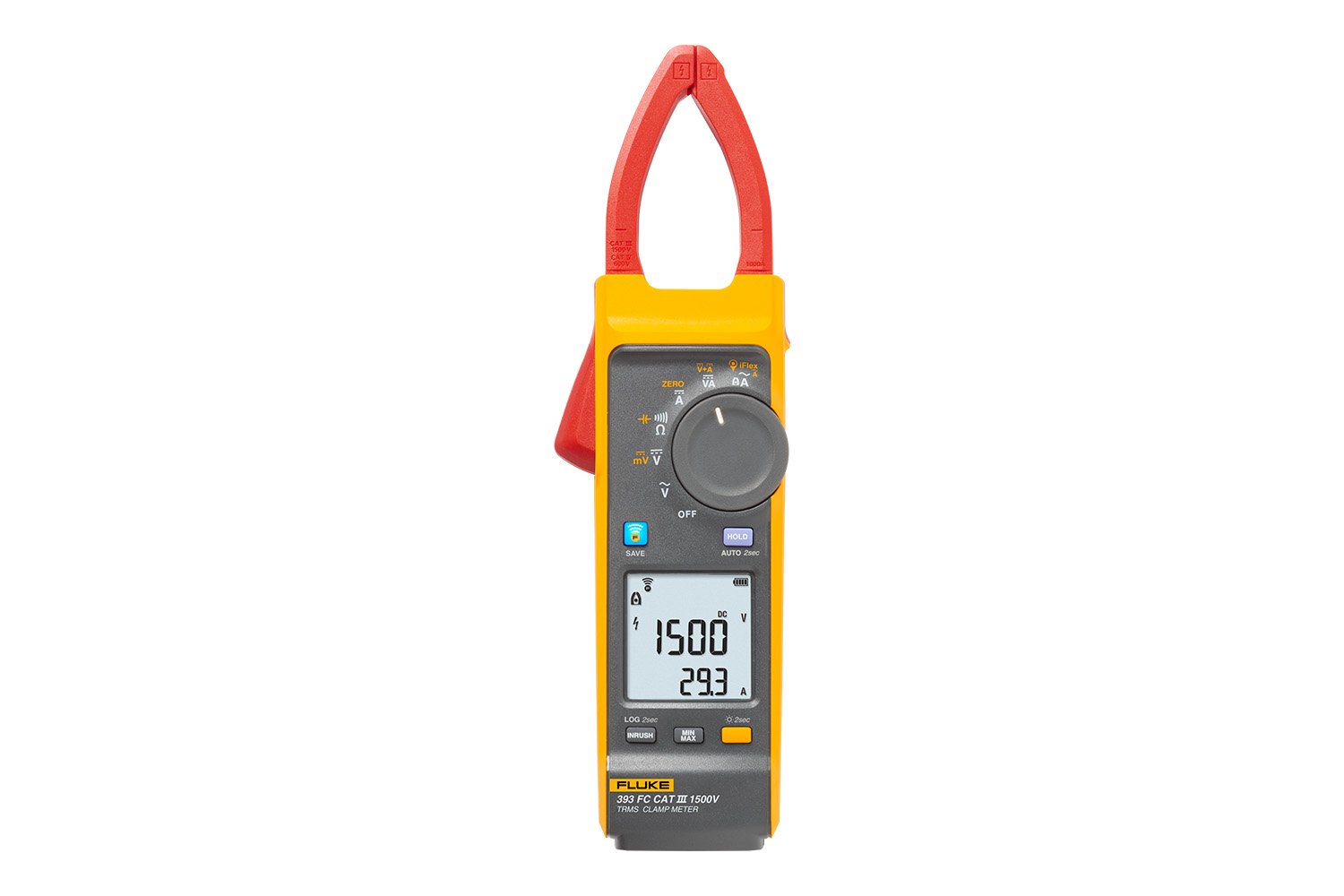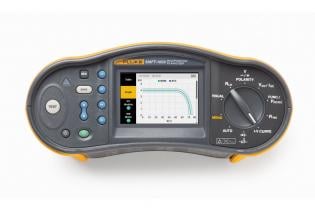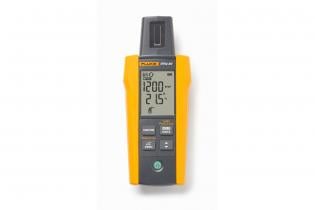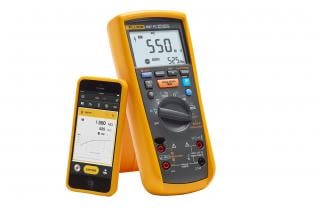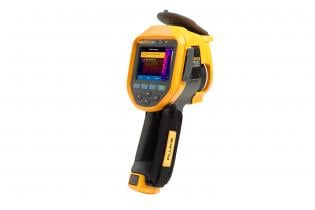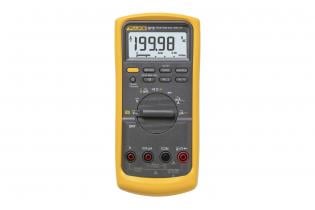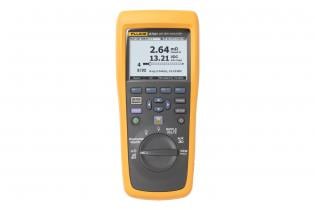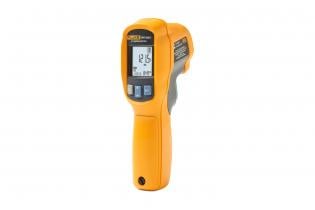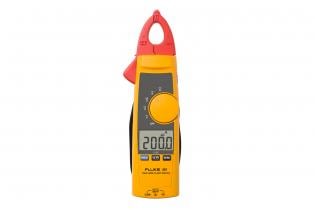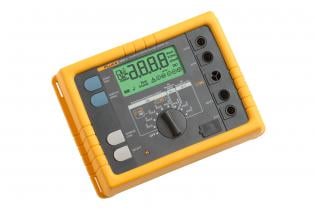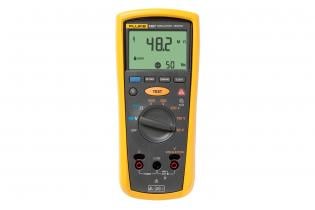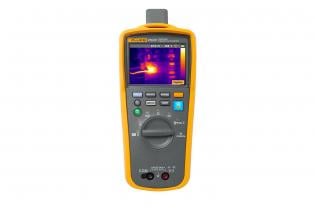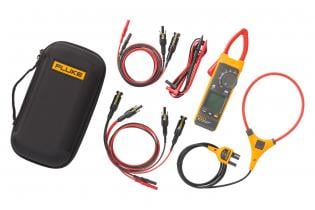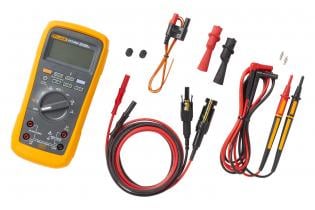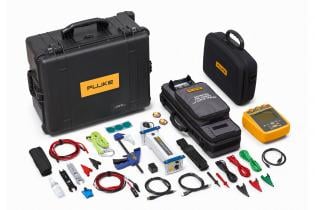Solar meter and solar tools for photovoltaic testing equipment
Get the right solar panel tester and measurement equipment for the job
The growth of the solar energy industry requires new solar testing equipment solutions for electricians, PV installers, and technicians. Fluke offers a range of specialized tools, including solar meters and other critical solar tools, for surveying, installing, maintaining, and reporting on solar installations. Whether you're commissioning a new PV array or performing routine maintenance on a solar farm or photovoltaic power station, Fluke's solar testing equipment has you covered.
PV systems have unique needs that require specialized tools for surveying, installing, maintaining and reporting on solar installations.
Best High-Voltage Solar Tools
Choose the right Fluke solar testing equipment for the job without compromising function or safety.
Fluke 283 FC/PV Solar Digital Multimeter and Wireless Current Clamp
The Fluke 283 FC/PV Solar Digital Multimeter and Wireless Current Clamp, True-RMS CAT III 1500V is...
Fluke 283 FC CAT III 1500V Digital Multimeter
The Fluke 283FC Solar Digital Multimeter, True-RMS CAT III 1500V is ideal for solar power systems,...
PVA-1500 Series PV Analyzer, I-V Curve Tracer
Measure and display I-V curves up to 1500V/30A, with advanced PV modeling, rapid sweeps, wireless ...
SMFT-1000 Solar Tools Kit: Fluke Multifunction PV Tester and Performance Analyzer, I-V Curve Tracer
Designed for PV installation and solar PV testing for systems that operate at 1000 V DC or under.
Fluke Solar Site Survey Irradiance Meter with Mounting Bracket
All-in-one solar irradiance meter ideal for PV installation and maintenance.
Fluke Solmetric PVA Charging Kit
Fluke Solmetric PVA Charging Kit: Charge your I-V unit or SolSensor with solar or external battery...
Fluke Solar Irradiance Meter
Instantaneous irradiance measurements up to 1400 w/m2. Includes temperature, compass and inclination...
Fluke 393 FC Solar Clamp Meter CAT III 1500 V
Ideal for work outdoors on solar arrays and wind power systems.
Fluke 1587 FC Insulation Multimeter
The Fluke 1587 FC Insulation Multimeter is a digital insulation tester and a full-featured, True-RMS...
Fluke Ti480 PRO Infrared Camera
Get a leading-edge visual infrared experience in a professional 640 x 480 thermal imager.
Fluke 87V MAX True-rms Digital Multimeter
Rugged, dustproof IP67 outer shell for the most extreme work sites. Measure up to 1000 V ac and dc.
Fluke 1630-2 FC Earth Ground Clamp
The Fluke 1630-2 FC Stakeless Earth Ground Clamp is a heavy-duty clamp jaw that allows you to test...
Fluke 500 Series Battery Analyzer
Ideal for maintenance, troubleshooting and performance testing of individual stationary batteries...
Fluke 64 MAX IR Thermometer
The Fluke 64 MAX thermometer has the precision you need to do your job accurately and will not break...
Fluke 365 Detachable Jaw True RMS AC/DC Clamp Meter
Fluke 365 AC clamp meter has a thin, small jaw with a flexible lead, so gaining access to wires and...
Fluke 1625-2 GEO Earth Ground Tester
The Fluke 1623-2 and 1625-2 GEO Earth Ground Testers offer data storage and download capabilities...
Fluke 1507 Insulation Resistance Tester
Fluke 1507 insulation resistance testers are rugged, compact, reliable & ideal for troubleshooting,...
Amprobe SOLAR-100 Solar Power Meter
Use the Amprobe SOLAR-100 Solar Power Meter to optimize placement of solar PV panels or solar water...
Fluke insulated long nose pliers
Stay safe and choose Fluke insulated needle nose pliers with side cutter and gripping zones. 8...
Fluke Norma 6000 Series Portable Power Analyzers
Get accurate, precise measurements. Portable, lightweight power analyzer with 10 hours of battery...
Fluke 279 FC True-rms Thermal Multimeter
Full-featured multimeter with integrated thermal imaging designed to increase your productivity and...
Fluke a283 FC True-RMS CAT III 1500V Wireless Current Clamp
The Fluke a283FC True-RMS CAT III 1500V Wireless Current Clamp simplifies troubleshooting without...
Pomona PVLEAD1 Solar PV Connector to 4 mm Test Lead Set
Ensures safe current and voltage measurements on PV modules and systems
Pomona PVLEAD3 Solar PV Solar Clamp Test Lead Set
Ideal for use with solar clamp meters that accept 4mm banana plugs.
Fluke Pack30 Professional Tool Backpack
The Fluke Pack30 tool backpack gives you a comfortable hands-free experience vs. traditional tool...
Fluke i410 AC/DC Current Clamp
The Fluke i410 AC/DC Current Clamp expands the functionality of digital multimeters and measures up...
SMFT-1000 Solar Tools Pro Kit: Fluke Multifunction PV Tester, I-V Curve Tracer with TruTest™ Software and Solar PV Leads
All-in-one PV testing solution kit designed for solar installation and inspections.
Solar Tools Kit with 393 FC Clamp Meter and Solar Test Leads
Ideal for PV installation technicians who work in high voltage dc environments.
Solar Tools Kit with 393 FC Clamp Meter, Irradiance Meter and Solar Test Leads
Ideal for PV installations and IV curve tracing.
Solar Tools Kit with 87V Max Digital Multimeter and Test Leads
Ideal for solar installations and troubleshooting PV arrays.
PVA-1500HE2 I-V Curve Tracer and 1537 Insulation Tester 2500V Kit
Optimize Solar Performance: PVA-1500HE2 PV Analyzer & 1537 Insulation Tester 2500V
PVA-1500HE2 I-V Curve Tracer Thermography Kit
Optimize Solar Performance: PVA-1500HE2 PV Analyzer & TiS75+ Thermal Camera
PVA-1500HE2 I-V Curve Tracer, Clamp and Multimeter Kit
Optimize Solar Performance: PVA-1500HE2 PV Analyzer, 393 FC Clamp Meter & 87V Multimeter
PVA-1500HE2 I-V Curve Tracer, Insulation, Clamp and Multimeter Kit
Optimize Solar Performance: PVA-1500HE2 PV Analyzer, 1587 FC Insulation Multimeter, 393 FC Clamp...
Frequently asked questions for solar meters and tools
What is a solar meter?
A solar meter, also known as a solar irradiance meter or pyranometer, is a device that measures the amount of solar energy or irradiance emitted by the sun. It is commonly used in solar power applications to optimize system performance and ensure it operates at peak efficiency. Solar meters can measure solar radiation in units of W/m2 and can accumulate PV yield production and local energy consumption to monitor and analyze PV plant performance. They also measure the efficiency of windows and other solar power devices.
What meter do you need for solar panels?
It would help to have a solar irradiance meter or a solar power meter for solar panels. These meters are designed to measure the intensity of sunlight in watts per square meter (W/m²). The data collected by these meters helps optimize the orientation and tilt of solar panels to ensure they receive the maximum sunlight, thus enhancing their energy output and efficiency.
How does a solar meter work?
A solar meter uses a photodiode sensor that converts solar radiation into an electrical current. This current is then measured and displayed as solar irradiance. The meter typically has a digital display that shows the solar power in W/m². Advanced models may also feature data logging, temperature measurement, and connectivity options like Bluetooth for easy data transfer and analysis.
How accurate is a solar meter?
The accuracy of a solar meter can vary, but high-quality models from reputable brands like Fluke offer accuracy levels of ±5% or better. Factors that affect accuracy include the quality of the sensor, calibration, and environmental conditions. Regular calibration of the solar meter is essential to maintain its accuracy and ensure reliable measurements.
How to read a solar meter?
To read a solar meter, look at the digital display for the current solar irradiance level, typically shown in W/m². Some meters provide additional information such as temperature, accumulated energy over time, and real-time graphs. Understanding these readings helps evaluate your solar panels' performance and efficiency, allowing you to make informed decisions about their placement and maintenance.
What is the best solar meter?
The best solar meter combines high accuracy, durability, and ease of use. Features include a wide measurement range, data logging capabilities, and robust construction. Fluke's solar meters are renowned for their precision, reliability, and user-friendly design, making them a top choice for solar professionals.
What is a solar power meter?
A solar power meter measures the power output of solar panels by detecting the intensity of solar radiation. This tool is essential for assessing the efficiency and performance of solar power systems. It also helps optimize the setup of solar panels to ensure they produce the maximum possible energy.
What type of meter do I need for solar power?
The type of meter you need for solar power will depend on your specific needs. For grid-tied solar systems, a bi-directional utility meter is required to track the electricity being transferred to the grid. On the other hand, a PV meter is used to measure how much electricity your solar system generates. Also, a solar irradiance meter or pyranometer can calculate the amount of solar radiation received by your solar panels. By using a combination of these meters, you can optimize the performance of your solar power system and ensure that it is operating at peak efficiency. For solar power applications, a pyranometer or a solar irradiance meter is typically used to measure the amount of solar radiation received.
How does a solar power meter work?
A solar power meter uses sensors to detect the intensity of solar radiation and converts this data into a readable electrical signal. The meter then displays this information, typically in watts per square meter (W/m²). Some advanced meters also provide additional features like data logging, temperature compensation, and connectivity options for detailed analysis and monitoring.
What kind of meter do you need for solar panels?
You need a solar irradiance meter or a solar power meter for solar panels. These tools measure the amount of sunlight hitting the panels and provide crucial data for optimizing their performance and ensuring maximum energy output. The data helps adjust the panel's orientation and angle to capture the most sunlight.
What is a solar panel meter?
A solar panel meter is a device used to measure the amount of solar energy received by a solar panel. It provides essential data to ensure the solar panel is positioned correctly and operates efficiently. This information is vital for monitoring and maintaining the performance of solar energy systems, ensuring they generate the expected amount of power.
How do you test solar power?
Testing solar power involves using a solar power meter or tester to measure the output of your solar panels. This includes checking the voltage, current, and overall efficiency to ensure your system functions properly. Regular testing helps identify any issues early and maintain optimal performance. Additionally, you may use thermal cameras to detect hot spots on panels and ensure uniform energy distribution.
How do you test a solar panel?
To test a solar panel, you use a tester or multimeter to measure the voltage and current output. This helps determine the panel's efficiency and identify any performance issues. Testing is usually conducted under standardized conditions to ensure accurate results. You may also use an IV curve tracer to get a detailed profile of the panel's performance.
What tools do you need for solar?
Essential tools for solar installations and maintenance include solar power meters, irradiance meters, multimeters, clamp meters, thermal imagers, and insulation testers. These tools help measure performance, ensure safety, and diagnose issues in solar power systems. Proper tools also ensure that solar panels are installed correctly and maintained efficiently, maximizing their lifespan and energy output.
What tools do solar technicians use?
Solar technicians use various tools, including solar irradiance meters, multimeters, clamp meters, thermal cameras, and insulation testers. These tools are crucial for installing, maintaining, and troubleshooting solar power systems. They help technicians ensure that solar panels operate at peak efficiency and identify potential issues that could affect performance. Additionally, technicians may use IV curve tracers and specialized software for detailed analysis and optimization of solar systems.
What is a PV meter?
A PV meter, or photovoltaic meter, is a device used to measure the performance of solar panels. It provides data on solar irradiance, voltage, and current, helping to ensure that the solar power system operates efficiently. PV meters are essential for monitoring and optimizing the performance of solar installations, ensuring they generate the maximum possible energy. They are also used to comply with regulatory standards and verify system performance against design specifications.
